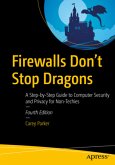- Gebundenes Buch
- Merkliste
- Auf die Merkliste
- Bewerten Bewerten
- Teilen
- Produkt teilen
- Produkterinnerung
- Produkterinnerung
This collaborative research project allows for fundamental advances not only in the understanding of the phenomena but also in the development of practical calculation methods that can be used by engineers. This collaborative research project allows for fundamental advances not only in the understanding of the phenomena but also in the development of practical calculation methods that can be used by engineers.
Andere Kunden interessierten sich auch für
![Darknet Darknet]() Lance HendersonDarknet16,99 €
Lance HendersonDarknet16,99 €![Firewalls Don't Stop Dragons Firewalls Don't Stop Dragons]() Carey ParkerFirewalls Don't Stop Dragons45,99 €
Carey ParkerFirewalls Don't Stop Dragons45,99 €![Spurlos im Internet Spurlos im Internet]() Andreas ErleSpurlos im Internet19,90 €
Andreas ErleSpurlos im Internet19,90 €![Internet of Crimes Internet of Crimes]() Gerald ReischlInternet of Crimes19,99 €
Gerald ReischlInternet of Crimes19,99 €![Personal Cybersecurity Personal Cybersecurity]() Marvin WaschkePersonal Cybersecurity38,99 €
Marvin WaschkePersonal Cybersecurity38,99 €![Darknet. Ein Leitfaden im Umgang mit dem dunklen Fleck im Deep Web Darknet. Ein Leitfaden im Umgang mit dem dunklen Fleck im Deep Web]() AnonymDarknet. Ein Leitfaden im Umgang mit dem dunklen Fleck im Deep Web27,95 €
AnonymDarknet. Ein Leitfaden im Umgang mit dem dunklen Fleck im Deep Web27,95 €![Basiswissen OSINT Basiswissen OSINT]() Mark B.Basiswissen OSINT19,99 €
Mark B.Basiswissen OSINT19,99 €-
-
-
This collaborative research project allows for fundamental advances not only in the understanding of the phenomena but also in the development of practical calculation methods that can be used by engineers. This collaborative research project allows for fundamental advances not only in the understanding of the phenomena but also in the development of practical calculation methods that can be used by engineers.
Hinweis: Dieser Artikel kann nur an eine deutsche Lieferadresse ausgeliefert werden.
Hinweis: Dieser Artikel kann nur an eine deutsche Lieferadresse ausgeliefert werden.
Produktdetails
- Produktdetails
- Verlag: Wiley
- Seitenzahl: 208
- Erscheinungstermin: 19. Juni 2018
- Englisch
- Abmessung: 241mm x 161mm x 17mm
- Gewicht: 433g
- ISBN-13: 9781786302021
- ISBN-10: 1786302020
- Artikelnr.: 50225600
- Herstellerkennzeichnung
- Libri GmbH
- Europaallee 1
- 36244 Bad Hersfeld
- gpsr@libri.de
- Verlag: Wiley
- Seitenzahl: 208
- Erscheinungstermin: 19. Juni 2018
- Englisch
- Abmessung: 241mm x 161mm x 17mm
- Gewicht: 433g
- ISBN-13: 9781786302021
- ISBN-10: 1786302020
- Artikelnr.: 50225600
- Herstellerkennzeichnung
- Libri GmbH
- Europaallee 1
- 36244 Bad Hersfeld
- gpsr@libri.de
Gayard Laurent, professor at the institut Catholique, Paris, France.
Preface ix
Introduction xiii
Part 1. New Frontiers And Governance of Digital Space 1
Chapter 1. Fragmentation and Compartmentalization of Virtual Space 3
1.1 The nymph Carna and Internet census 3
1.2 Dimensions of cyberspace 5
1.3 Deep web, darknet and dark web 8
Chapter 2. A Society Of Control And Panopticism 13
2.1 Horizontal panopticism and cyber-narcissism 13
2.2 The neutrality of the network in question 15
2.2.1 How can network neutrality be preserved? 18
2.2.2 A threatened principle 19
2.3 Going toward an Internet 3.0 and a new form of digital civility? 22
2.3.1 Is cyberspace a public space? 22
2.3.2 Tyrannies of privacy 24
Chapter 3. The Internet, A Governance Subject To Controversy 27
3.1 ICANN, an influenced institution 27
3.1.1 Is this the end of US supremacy? 28
3.1.2 The role of the GAC 29
3.2 Cybersecurity, domains and electronic addressing 32
3.2.1 The essential role of WHOIS 34
3.2.2 Domain name extension and migration from IPv4 to IPv6 37
3.3 Who regulates those who are in control? 39
3.3.1 Conflict within ICANN 40
3.3.2 Encrypted networks: a major security issue for ICANN 42
Part 2. Crypto-Anarchism, Cryptography and Hidden Networks 45
Chapter 4. From The Arpanet To The Darknet: When States Lose Cryptographic
Warfare 49
4.1 From Minitel to ARPANET 49
4.1.1 Rapid growth 51
4.1.2 The privatization of the Internet 52
4.2 The rise of asymmetric cryptography 53
4.2.1 Steganography 53
4.2.2 Modern cryptographic methods 56
4.2.3 Asymmetric cryptography 57
4.3 "The Crypto Wars are over!" 60
4.3.1 Planetary electronic monitoring 62
4.3.2 "Rendering Big Brother obsolete" 64
4.3.3 Cryptography at the service of hidden networks 68
Chapter 5. From Sneaker Nets To Darknets 71
5.1 Peer to peer: the first darknets 71
5.1.1 P2P against the entertainment industry: David versus Goliath 73
5.1.2 The BitTorrent revolution 77
5.1.3 The emergence of darknets 81
5.2 "Netopias" and darknets: the appearance of parallel networks 84
5.2.1 Cypherpunks and cyberpunk 84
5.2.2 Crypto-anarchism and activism: Peekabooty 88
5.2.3 Freenet 90
5.2.4 It is a small world... 93
5.3 The Tor network 98
5.3.1 The origins of Tor 100
5.3.2 The Tor paradox 103
5.3.3 How Tor works 105
5.3.4 The principle of the .onion address 108
5.3.5 An evolution of Tor uses thanks to Tor2Web? 112
Chapter 6. Geopolitics and Cybersecurity 117
6.1 From "hacktivism" to "cyberwarfare" 117
6.1.1 The first hackers 118
6.1.2 When states engage in cyberwarfare 120
6.1.3 Computer attacks of an unprecedented magnitude 122
6.1.4 The darknet: cybercrime market 124
6.2 Cybercrime, politics and subversion in the "half-world" 126
6.2.1 The "half-world" appeal 130
6.2.2 Fighting crime and Bitcoins: current and future economic and security
issues 134
Conclusion 141
Appendices 145
Appendix 1 147
Appendix 2 153
Glossary 157
Bibliography 163
Index 169
Introduction xiii
Part 1. New Frontiers And Governance of Digital Space 1
Chapter 1. Fragmentation and Compartmentalization of Virtual Space 3
1.1 The nymph Carna and Internet census 3
1.2 Dimensions of cyberspace 5
1.3 Deep web, darknet and dark web 8
Chapter 2. A Society Of Control And Panopticism 13
2.1 Horizontal panopticism and cyber-narcissism 13
2.2 The neutrality of the network in question 15
2.2.1 How can network neutrality be preserved? 18
2.2.2 A threatened principle 19
2.3 Going toward an Internet 3.0 and a new form of digital civility? 22
2.3.1 Is cyberspace a public space? 22
2.3.2 Tyrannies of privacy 24
Chapter 3. The Internet, A Governance Subject To Controversy 27
3.1 ICANN, an influenced institution 27
3.1.1 Is this the end of US supremacy? 28
3.1.2 The role of the GAC 29
3.2 Cybersecurity, domains and electronic addressing 32
3.2.1 The essential role of WHOIS 34
3.2.2 Domain name extension and migration from IPv4 to IPv6 37
3.3 Who regulates those who are in control? 39
3.3.1 Conflict within ICANN 40
3.3.2 Encrypted networks: a major security issue for ICANN 42
Part 2. Crypto-Anarchism, Cryptography and Hidden Networks 45
Chapter 4. From The Arpanet To The Darknet: When States Lose Cryptographic
Warfare 49
4.1 From Minitel to ARPANET 49
4.1.1 Rapid growth 51
4.1.2 The privatization of the Internet 52
4.2 The rise of asymmetric cryptography 53
4.2.1 Steganography 53
4.2.2 Modern cryptographic methods 56
4.2.3 Asymmetric cryptography 57
4.3 "The Crypto Wars are over!" 60
4.3.1 Planetary electronic monitoring 62
4.3.2 "Rendering Big Brother obsolete" 64
4.3.3 Cryptography at the service of hidden networks 68
Chapter 5. From Sneaker Nets To Darknets 71
5.1 Peer to peer: the first darknets 71
5.1.1 P2P against the entertainment industry: David versus Goliath 73
5.1.2 The BitTorrent revolution 77
5.1.3 The emergence of darknets 81
5.2 "Netopias" and darknets: the appearance of parallel networks 84
5.2.1 Cypherpunks and cyberpunk 84
5.2.2 Crypto-anarchism and activism: Peekabooty 88
5.2.3 Freenet 90
5.2.4 It is a small world... 93
5.3 The Tor network 98
5.3.1 The origins of Tor 100
5.3.2 The Tor paradox 103
5.3.3 How Tor works 105
5.3.4 The principle of the .onion address 108
5.3.5 An evolution of Tor uses thanks to Tor2Web? 112
Chapter 6. Geopolitics and Cybersecurity 117
6.1 From "hacktivism" to "cyberwarfare" 117
6.1.1 The first hackers 118
6.1.2 When states engage in cyberwarfare 120
6.1.3 Computer attacks of an unprecedented magnitude 122
6.1.4 The darknet: cybercrime market 124
6.2 Cybercrime, politics and subversion in the "half-world" 126
6.2.1 The "half-world" appeal 130
6.2.2 Fighting crime and Bitcoins: current and future economic and security
issues 134
Conclusion 141
Appendices 145
Appendix 1 147
Appendix 2 153
Glossary 157
Bibliography 163
Index 169
Preface ix
Introduction xiii
Part 1. New Frontiers And Governance of Digital Space 1
Chapter 1. Fragmentation and Compartmentalization of Virtual Space 3
1.1 The nymph Carna and Internet census 3
1.2 Dimensions of cyberspace 5
1.3 Deep web, darknet and dark web 8
Chapter 2. A Society Of Control And Panopticism 13
2.1 Horizontal panopticism and cyber-narcissism 13
2.2 The neutrality of the network in question 15
2.2.1 How can network neutrality be preserved? 18
2.2.2 A threatened principle 19
2.3 Going toward an Internet 3.0 and a new form of digital civility? 22
2.3.1 Is cyberspace a public space? 22
2.3.2 Tyrannies of privacy 24
Chapter 3. The Internet, A Governance Subject To Controversy 27
3.1 ICANN, an influenced institution 27
3.1.1 Is this the end of US supremacy? 28
3.1.2 The role of the GAC 29
3.2 Cybersecurity, domains and electronic addressing 32
3.2.1 The essential role of WHOIS 34
3.2.2 Domain name extension and migration from IPv4 to IPv6 37
3.3 Who regulates those who are in control? 39
3.3.1 Conflict within ICANN 40
3.3.2 Encrypted networks: a major security issue for ICANN 42
Part 2. Crypto-Anarchism, Cryptography and Hidden Networks 45
Chapter 4. From The Arpanet To The Darknet: When States Lose Cryptographic
Warfare 49
4.1 From Minitel to ARPANET 49
4.1.1 Rapid growth 51
4.1.2 The privatization of the Internet 52
4.2 The rise of asymmetric cryptography 53
4.2.1 Steganography 53
4.2.2 Modern cryptographic methods 56
4.2.3 Asymmetric cryptography 57
4.3 "The Crypto Wars are over!" 60
4.3.1 Planetary electronic monitoring 62
4.3.2 "Rendering Big Brother obsolete" 64
4.3.3 Cryptography at the service of hidden networks 68
Chapter 5. From Sneaker Nets To Darknets 71
5.1 Peer to peer: the first darknets 71
5.1.1 P2P against the entertainment industry: David versus Goliath 73
5.1.2 The BitTorrent revolution 77
5.1.3 The emergence of darknets 81
5.2 "Netopias" and darknets: the appearance of parallel networks 84
5.2.1 Cypherpunks and cyberpunk 84
5.2.2 Crypto-anarchism and activism: Peekabooty 88
5.2.3 Freenet 90
5.2.4 It is a small world... 93
5.3 The Tor network 98
5.3.1 The origins of Tor 100
5.3.2 The Tor paradox 103
5.3.3 How Tor works 105
5.3.4 The principle of the .onion address 108
5.3.5 An evolution of Tor uses thanks to Tor2Web? 112
Chapter 6. Geopolitics and Cybersecurity 117
6.1 From "hacktivism" to "cyberwarfare" 117
6.1.1 The first hackers 118
6.1.2 When states engage in cyberwarfare 120
6.1.3 Computer attacks of an unprecedented magnitude 122
6.1.4 The darknet: cybercrime market 124
6.2 Cybercrime, politics and subversion in the "half-world" 126
6.2.1 The "half-world" appeal 130
6.2.2 Fighting crime and Bitcoins: current and future economic and security
issues 134
Conclusion 141
Appendices 145
Appendix 1 147
Appendix 2 153
Glossary 157
Bibliography 163
Index 169
Introduction xiii
Part 1. New Frontiers And Governance of Digital Space 1
Chapter 1. Fragmentation and Compartmentalization of Virtual Space 3
1.1 The nymph Carna and Internet census 3
1.2 Dimensions of cyberspace 5
1.3 Deep web, darknet and dark web 8
Chapter 2. A Society Of Control And Panopticism 13
2.1 Horizontal panopticism and cyber-narcissism 13
2.2 The neutrality of the network in question 15
2.2.1 How can network neutrality be preserved? 18
2.2.2 A threatened principle 19
2.3 Going toward an Internet 3.0 and a new form of digital civility? 22
2.3.1 Is cyberspace a public space? 22
2.3.2 Tyrannies of privacy 24
Chapter 3. The Internet, A Governance Subject To Controversy 27
3.1 ICANN, an influenced institution 27
3.1.1 Is this the end of US supremacy? 28
3.1.2 The role of the GAC 29
3.2 Cybersecurity, domains and electronic addressing 32
3.2.1 The essential role of WHOIS 34
3.2.2 Domain name extension and migration from IPv4 to IPv6 37
3.3 Who regulates those who are in control? 39
3.3.1 Conflict within ICANN 40
3.3.2 Encrypted networks: a major security issue for ICANN 42
Part 2. Crypto-Anarchism, Cryptography and Hidden Networks 45
Chapter 4. From The Arpanet To The Darknet: When States Lose Cryptographic
Warfare 49
4.1 From Minitel to ARPANET 49
4.1.1 Rapid growth 51
4.1.2 The privatization of the Internet 52
4.2 The rise of asymmetric cryptography 53
4.2.1 Steganography 53
4.2.2 Modern cryptographic methods 56
4.2.3 Asymmetric cryptography 57
4.3 "The Crypto Wars are over!" 60
4.3.1 Planetary electronic monitoring 62
4.3.2 "Rendering Big Brother obsolete" 64
4.3.3 Cryptography at the service of hidden networks 68
Chapter 5. From Sneaker Nets To Darknets 71
5.1 Peer to peer: the first darknets 71
5.1.1 P2P against the entertainment industry: David versus Goliath 73
5.1.2 The BitTorrent revolution 77
5.1.3 The emergence of darknets 81
5.2 "Netopias" and darknets: the appearance of parallel networks 84
5.2.1 Cypherpunks and cyberpunk 84
5.2.2 Crypto-anarchism and activism: Peekabooty 88
5.2.3 Freenet 90
5.2.4 It is a small world... 93
5.3 The Tor network 98
5.3.1 The origins of Tor 100
5.3.2 The Tor paradox 103
5.3.3 How Tor works 105
5.3.4 The principle of the .onion address 108
5.3.5 An evolution of Tor uses thanks to Tor2Web? 112
Chapter 6. Geopolitics and Cybersecurity 117
6.1 From "hacktivism" to "cyberwarfare" 117
6.1.1 The first hackers 118
6.1.2 When states engage in cyberwarfare 120
6.1.3 Computer attacks of an unprecedented magnitude 122
6.1.4 The darknet: cybercrime market 124
6.2 Cybercrime, politics and subversion in the "half-world" 126
6.2.1 The "half-world" appeal 130
6.2.2 Fighting crime and Bitcoins: current and future economic and security
issues 134
Conclusion 141
Appendices 145
Appendix 1 147
Appendix 2 153
Glossary 157
Bibliography 163
Index 169








